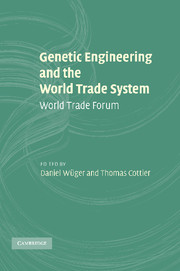Book contents
- Frontmatter
- Contents
- List of contributors
- List of abbreviations
- PART I Introduction and systemic issues
- PART II Intellectual property and gene technology: issues at stake and possible options
- PART III Food security, trade and agricultural production with genetically modified organisms
- 7 Biotechnology in the energy sector: some implications for developing countries
- 8 Coexistence and liability: implications for international trade drawn from the Swiss example
- 9 Food security and agricultural production with genetically modified organisms: a comment
- PART IV Food safety, international trade and biotechnology
- PART V Medical research, cloning and international trade
- Index
7 - Biotechnology in the energy sector: some implications for developing countries
Published online by Cambridge University Press: 06 October 2009
- Frontmatter
- Contents
- List of contributors
- List of abbreviations
- PART I Introduction and systemic issues
- PART II Intellectual property and gene technology: issues at stake and possible options
- PART III Food security, trade and agricultural production with genetically modified organisms
- 7 Biotechnology in the energy sector: some implications for developing countries
- 8 Coexistence and liability: implications for international trade drawn from the Swiss example
- 9 Food security and agricultural production with genetically modified organisms: a comment
- PART IV Food safety, international trade and biotechnology
- PART V Medical research, cloning and international trade
- Index
Summary
Introduction
The era of ‘easy’ energy is over. The international community is now asking itself a number of questions which are crucial for the sustainable development prospects of all countries. These questions – How do we meet the energy needs of the developing countries and those of the industrialised nations? What role will renewables and alternative energies play? What is the best way to protect the environment? How do we accelerate energy conservation efforts? – are on the agendas of governments, intergovernmental organisations, corporations, non-governmental organisations (NGOs), as well as of ordinary citizens. New technologies, and more specifically biotechnology, may play a role in providing answers to these questions. This paper analyses recent developments in the field of biotechnology applied in the energy sector, and focuses on the opportunities that biotechnology may offer in terms of increasing energy security, mitigating greenhouse gas emissions, increasing manufacturing and export prospects, and fostering the development of rural communities. Biotechnology, however, is not without uncertainties, especially for developing countries. Some specific challenges that they are likely to face and some possible solutions are therefore discussed.
From plants to chemicals and back to plants
Biotechnology is that set of technologies that come from adapting and modifying the biological organisms, processes, products and systems found in nature for the purpose of producing goods and services. Biotechnology includes genetic engineering (or recombinant DNA technology) which is the technique of removing, modifying or adding genes to a DNA molecule in order to change the information it contains.
- Type
- Chapter
- Information
- Genetic Engineering and the World Trade SystemWorld Trade Forum, pp. 151 - 174Publisher: Cambridge University PressPrint publication year: 2008

